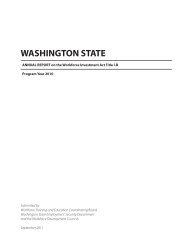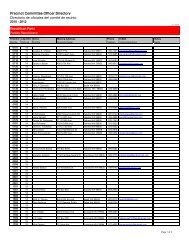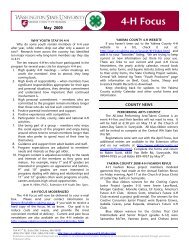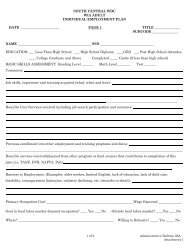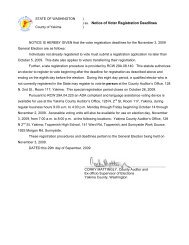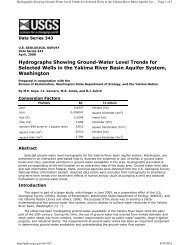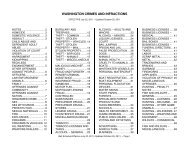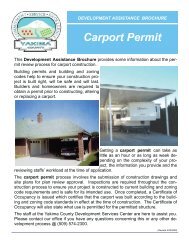Washington State Elections Glossary English ... - Yakima County
Washington State Elections Glossary English ... - Yakima County
Washington State Elections Glossary English ... - Yakima County
You also want an ePaper? Increase the reach of your titles
YUMPU automatically turns print PDFs into web optimized ePapers that Google loves.
UKRAINE-RUSSIA RELATIONS IN THE ENERGY SECTORunits of the Russian design: two power units withVVER-440 reactors (with the rated electric power of 420and 415 MW, respectively) and 13 VVER-1000 powerunits (1,000 MW each), two of them commissionedin 2004. 6 Active Ukrainian NPPs are operated byEnergoatom NNEGC. In 2009, NPPs accounted for 48%of electricity generation. 7Over the past five years, thanks to safetyenhancement measures, better technical maintenance,replacement of equipment, professional developmentof personnel, power units at NPPs were operating quitestably. 8 In particular, in 2009, compared to the previousyear, the number of load shedding instances decreased1.8 times, power unit shutdowns – 2.3 times; thequantity of electricity not generated because of failuresfell almost four-fold; no accidents or incidents underthe International Nuclear Event Scale (INES) wereregistered at NPPs.Operation and extension of service life of powerunits. 9 Ukrainian and Russian operators interact in linewith the Programme of cooperation between EnergoatomNNEGC and the Russian Rosenergoatom concern,annually approved under the interdepartmental Agreementof scientific-technological cooperation of December 2,1999. 10Currently, the most urgent tasks that require jointefforts of the Ukrainian and Russian parties are thefollowing:• Introduction of power cycling at UkrainianNPPs. The need of that step stems from theinsufficient throughput of Ukrainian power grids,its difficulty being that VVER reactors and theirnuclear fuel were not designed for operation in thepower cycling mode. 11In 2003, Energoatom NNEGC and TVEL OJSC agreedthe Programme of work for introduction of power cyclingat Ukrainian NPPs, involving Kurchatov Institute RussianResearch Center, Hydropress Design Bureau and otherinstitutions. K2 power unit was chosen for pilot trials.The beginning of its trial operation in the power cyclingmode is planned for 2011. The documents necessary forthe project start are already available. 12Introduction of power cycling may, first, have apositive effect on the service life of power units andadopted design limitations as to the core operationparameters, second, it will promote the stability ofUkraine’s energy system (first of all, the networkfrequency) in the conditions of daily/seasonal fluctuationof demand and economy of resources (nuclear fuel), third,it is set to enhance the competitiveness of UkrainianNPPs: Energoatom NNEGC hopes that it will be ableto sell redundant electricity (so-called power cyclingcomponent) at a rate higher than basic.• Extension of service life of NPP power units inexcess of the designed term. 13 In line with theEnergy Strategy of Ukraine, by 2018, it is plannedto extend the service life of 12 out of 15 activepower units, first of all, units 1-2 at the Rivne andunit 1 at the South Ukrainian NPPs – since theirdesigned terms expire 2010-2012. EnergoatomNNEGC is performing relevant preparatoryoperations in line with the ComprehensiveProgramme of work for extension of service lifeof active NPP units. 14Cooperation with Russian counterparts in that fieldis of particular importance, since Russia has vastexperience of extending the service life of VVERreactors at its NPPs: in 2001-2009, it extended operationof 13 power units with the aggregate installed power of6.8 MW. That is why the domain “modernisation andextension of service life of NPPs” in Ukraine-Russiacooperation is deemed especially important. In particular,within its framework, common documents are drawn up; 15the Russian experience of survey of the current state ofequipment at Ukrainian NPPs is employed; specialistsfrom lead Russian institutions are immediately involvedin practical work at Ukrainian NPP sites.6To denominate specific features of reactor unit (reactor) construction, different terms are used: development, project, construction, design. This text usesthe word “design”.782.9 billion KW of electricity was generated, which is 7.7% less than in 2008; the installed power utilisation factor equalled 68.4%, or 5.5% less. Thedecrease in those figures is attributed to the economic crisis and associated decline of demand for electricity.8Those steps are mainly taken under the Summary Programme of safety enhancement at Ukrainian NPPs, combining the Comprehensive Programme of workfor extension of NPP service life and the Plan of Measures at implementation of the Concept of safety enhancement at active NPP units.9For more detail see: Nuclear energy in the world and in Ukraine…, p.16-19.10Currently effective is the Programme approved by Energoatom NNEGC Order No.1203 of December 31, 2009. The Programme envisaged various measures –from joint meetings of the Council of Chief Engineers of Russian and Ukrainian NPPs and resumption of work of the VVER-440, VVER-1000 club to conclusionof agreements of direct partnership between NPPs (Khmelnytskyj and Volgodonskaya, Zaporizhya and Balakovskaya, Rivne and Novovoronezhskaya, SouthUkrainian and Kalininskaya).11For that reason the <strong>State</strong> Nuclear Regulatory Committee is cautious about introduction of power cycling, insisting that it may be introduced only at powerunits whose safety fully meets international standards. See: Mykolajchuk Ye.: The state is a very naïve and trustful NPP owner. – AtomNews, March 17, 2010,http://www.atomnews.info (in Russian).12The developed documents include: the draft Programme of work at substantiation and introduction of daily power cycling in the range of 100-75-100% of therated power at VVER-1000 power units of Ukrainian NPPs; the Conceptual technical solution of introduction of the mode of daily power regulation in the rangeof 100-75-100% of the rated power at K2 power unit. Finalised were: Section 60 of the Requirements of general safety of NPP reactor units for substantiation ofsafety of K2 operation in the power regulation mode, and the Preliminary report of analysis of safety of K2 operation in that mode. The Technical solution of trialoperation of K2 in the power regulation mode was presented for approval to the <strong>State</strong> Nuclear Regulatory Committee.13See also: Nuclear power in Ukraine: safety and development..., p.23-24.14The Programme was approved by CMU Resolution No.263 of April 29, 2004.15The guideline document “Monitoring of NPP building structures” has been drawn up (effective in Ukraine from March 2007), development of the document“Management of ageing nuclear station building structures: Technical requirements” is nearing completion.38 • RAZUMKOV CENTRE • NATIONAL SECURITY & DEFENCE • No.6, 2010



